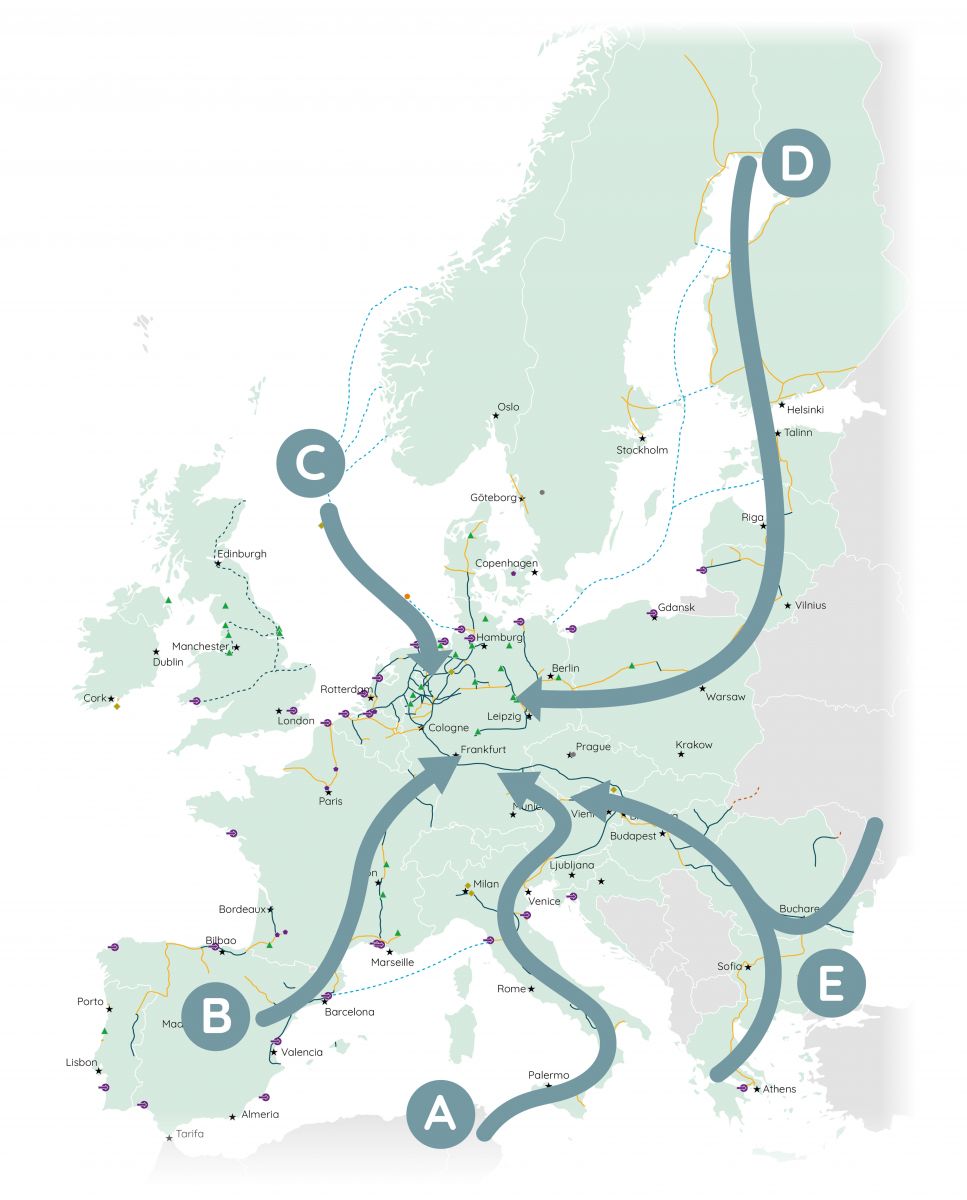Amber Grid, together with European gas transmission system operators, has analysed and set out a vision to accelerate the development of a European hydrogen network by 2030. Five potential large-scale hydrogen supply corridors in Europe have been envisaged and announced by the European Hydrogen Backbone (EHB) initiative. The corridors will initially connect domestic local supply and demand in Europe, before expanding & connecting European regions and neighbouring countries with low-cost hydrogen export potential.
These corridors will play a key role as cost-efficient solution to transport large volumes of low-cost hydrogen supply to demand centers. Pipeline transport offers a cost-efficient solution to connect areas of large amounts of hydrogen excess supply with regions with hydrogen demand, especially when including repurposing of existing gas infrastructure.
The five corridors span across both domestic and import supply markets, consistent with the three import corridors identified by the REPowerEU plan. The deployment of such a European Hydrogen Backbone infrastructure by 2030 will enable market actors to develop supply and demand more rapidly in a cost-efficient manner.
The corridor analysis has identified sufficient hydrogen supply to exceed the European 2030 domestic supply targets, contributing to European energy independence and security of supply. EHB has identified 12 Mt (~400 TWh) of potential EU hydrogen supply, exceeding the domestic, REPowerEU target of 10 Mt of green hydrogen by 2030. In addition, hydrogen import potentials have been identified. EHB also identified a large share of EU hydrogen demand to meet the 2030 target, with an expectation for 2030 demand to accelerate further following the REPowerEU publication. Both hydrogen supply and demand will substantially increase towards 2040.
The five hydrogen supply corridors are:
• Corridor A: North Africa & Southern Europe
• Corridor B: Southwest Europe & North Africa
• Corridor C: North Sea
• Corridor D: Nordic and Baltic regions
• Corridor E: East and South-East Europe
Participating in Corridor D, which covers the Nordic and Baltic regions Lithuania will contribute to the development of the European hydrogen network. Lithuanian gas transmission system operator Amber Grid is ready to integrate into this energy transformation process with its infrastructure and acquired competencies.
The Nordic-Baltic Hydrogen Corridor will provide access to low-cost hydrogen produced from renewable onshore and offshore wind energy sources. Corridor D countries including Sweden, Denmark, Finland, Estonia, Latvia, Lithuania, Poland, Czechia and Germany will create a network of 13,500 km of hydrogen pipelines and will be able to supply 184 TWh of green hydrogen by 2030 and more than 500 TWh of hydrogen by 2040.
To ensure the development of these supply corridors by 2030, speed is of essence and action is needed now. Five key concrete actions:
o Foster development of new and repurposed hydrogen infrastructure
o Unlock financing to fast-track hydrogen infrastructure deployment
o Simplify and shorten planning and permitting procedures
o Intensify energy partnerships with exporting, non-EHB countries
o Facilitate integrated energy system planning
The members of the EHB initiative recommend to the EC to consider the establishment of hydrogen supply corridors by 2030 as front-running infrastructure as a political objective, in order to ensure the fulfilment of REPowerEU targets
The summary of the report can be accessed
here
The full analysis report can be accessed
here
An open initiative
The EHB aims to accelerate Europe’s decarbonisation journey by defining the critical role of hydrogen infrastructure – based on existing and new pipelines – in enabling the development of a competitive, liquid, pan-European renewable and low-carbon hydrogen market. The initiative seeks to foster market competition, security of supply, and cross-border collaboration between European countries and their neighbours. The EHB initiative is looking forward to continuing to discuss its vision with stakeholders including policy makers, companies, and initiatives along the hydrogen value chain.
